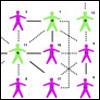
Session Overview
 |
This lecture returns to graph theory. It defines and gives examples of some classic graph problems: shortest path, shortest weighted path, cliques, and min-cut. It then shows how memoization can be used to speed up some algorithms. Centers for Disease Control and Prevention. This image is in the public domain. |
Session Activities
Lecture Videos
-
Lecture 22: Using Graphs to Model Problems, Part 2 (00:48:54)
Lecture 22: Using Graphs to Model Problems, Part 2
> Download from iTunes U (MP4 - 107MB)
> Download from Internet Archive (MP4 - 107MB)
About this Video
Topics covered: Dynamic programming, optimal path, overlapping subproblems, weighted edges, specifications, restrictions, efficiency, pseudo-polynomials.
Resources
Recitation Videos
-
Recitation 9: Directed and Undirected Node Graphs (00:49:58)
Recitation 9: Directed and Undirected Node Graphs
> Download from iTunes U (MP4 - 108MB)
> Download from Internet Archive (MP4 - 108MB)
About this Video
Topics covered: Node graphs, nodes, edges, directed and undirected graphs, weighted edges, depth-first search, breadth-first search, graph cycles, children of nodes, shortest path, lambda functions.
Check Yourself
What is memoization?
› View/hide answer
Why is memoization important?
› View/hide answer
Problem Sets
Problem Set 10: Clustering (Due)
Every decade, the United States Census takes place. The census collects a lot of information from the population around the United States. In this problem set, we are going to use k-means clustering to analyze this information.
- Instructions (PDF)
- Code Files (ZIP) (This ZIP file contains: 1 .py file and 1 .txt file.)
Note: Solutions are not available for this assignment.
Problem Set 11 (Assigned)
Problem set 11 is assigned in this session. The instructions and solutions can be found on the session page where it is due, Lecture 24 Avoiding Statistical Fallacies.
